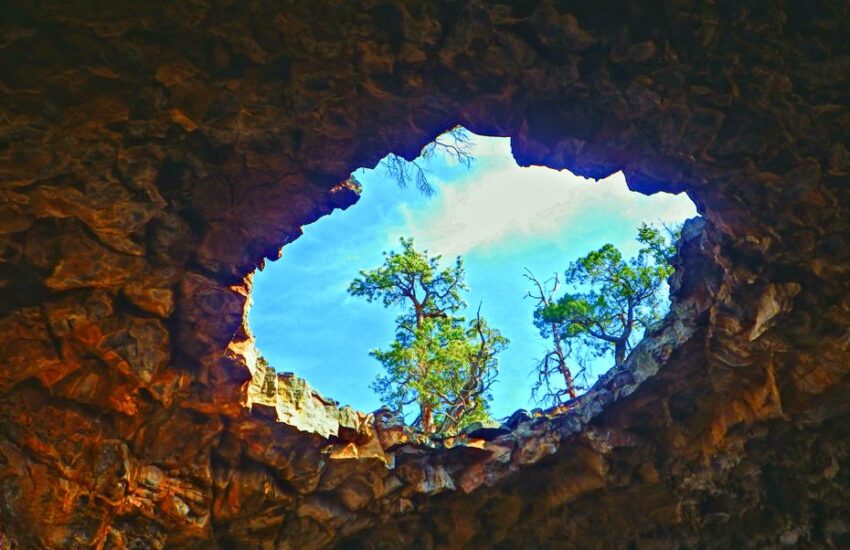- Researchers discovered evidence that humans lived in lava tubes and caves on the Arabia Peninsula across large spans of time.
- The find should help experts decipher the archaeological record that often gets wiped out by a lack of preservation in arid regions.
- Cave markings show a pastoral existence from the Stone Age through to the Bronze Age.
Arabian Peninsula lava tubes formed by molten lava created a respite for ancient herders and their flocks. New evidence shows that, from the Stone Age through to the Bronze Age, travelers used caves, tubes, and tunnel systems to house livestock and rest on journeys from one oasis to the next.
The new research comes from a study—led by Griffith University and published in PLOS One—that investigated the Umm Jirsan tunnel system in northwest Saudi Arabia. The team behind the study showed (for the first time) evidence of both human and animal interaction, with the caves dating as far back as potentially 10,000 years ago.
“Our findings at Umm Jirsan provide a rare glimpse into the lives of ancient peoples in Arabia, revealing repeated phases of human occupation and shedding light on the pastoralist activities that once thrived in this landscape,” Matthew Stewart, lead researcher at Australia’s Griffith University, said in a statement. “This site likely served as a crucial waypoint along pastoral routes, linking key oases and facilitating cultural exchange and trade.”
The bones of humans found in the system range from just 150 years ago to 6,000 years ago. Additional evidence—such as pottery, sediment, and animal bones—shows that the tunnel usage started around 7,000 to 10,000 years ago. Animal bones were also found, helping to fill out the understanding of the site’s occupation.
“Our results reveal repeated phases of human occupation of the site ranging from at least the Neolithic through to the Chalcolithic/Bronze Age,” the authors wrote in the study.
The team found rock art pointing to the use of the lava tubes and surrounding areas. Depictions of cattle, sheep, goats, and dogs, the authors say, corroborate the prehistoric livestock practices and herd composition of the region.
The evidence left behind in the tubes helped researchers date the find and fill in the gaps of the potential lifestyle of ancient peoples. The lack of evidence also tells a story. With certain items missing from the Umm Jirsan find that are common in similar discoveries, the researchers we able to conclude that the lava tubes likely served only as a waypoint—a place of temporary shelter and not a permanent home.
Additional isotopic analysis of the animal remains shows that the herders allowed livestock to feed on wild grass and shrubs, while the humans had a protein-rich diet featuring plant consumption that increased over time.
The animals likely joined the humans in the caves, made possible by the sheer size of the Umm Jirsan tunnel system—according to CNN, it runs roughly a mile in length and features areas up to 39 feet high and nearly 150 feet wide.
Arid environments often make it difficult to preserve archaeological sites, so locating the lava tubes and caves on the Arabian Peninsula allows for new understanding of human populations—and their movements—through the area. Going underground really made it possible to conduct a comprehensive study of the region for the first time, according to professor Michael Petraglia.
“These findings underscore the immense potential for interdisciplinary investigations in caves and lava tubes,” Petraglia said in a statement, “offering a unique window into Arabia’s ancient past.”
Human movement between the Stone Age and Bronze Age in the Arabia region isn’t fully understood. While people were creating settlements near green areas, finding this evidence of tunnel use should help paint a more vivid picture of human movement between locations, and show just how animals and plants played central roles in the culture of the time.
“Collectively,” Stewart told CNN, “the archaeological findings at the site and in the surrounding landscape paint a picture of recurrent use of the Umm Jirsan Lava Tube over millennia.”
Tim Newcomb is a journalist based in the Pacific Northwest. He covers stadiums, sneakers, gear, infrastructure, and more for a variety of publications, including Popular Mechanics. His favorite interviews have included sit-downs with Roger Federer in Switzerland, Kobe Bryant in Los Angeles, and Tinker Hatfield in Portland.

